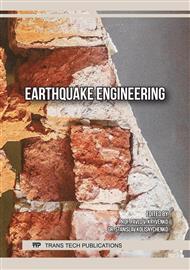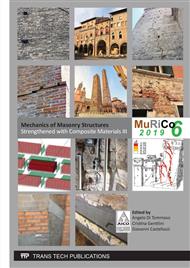[1]
S. Lagomarsino and S. Podesta`, Damage and Vulnerability Assessment of Churches after the 2002 Molise, Italy, Earthquake,, Earthq. Spectra, vol. 20, no. S1, pp. S271–S283, Jul. (2004).
DOI: 10.1193/1.1767161
Google Scholar
[2]
L. Krstevska, L. Tashkov, N. Naumovski, G. Florio, A. Formisano, A. Fornaro, and R. Landolfo, In-situ experimental testing of four historical buildings damaged during the 2009 L'Aquila earthquake,, COST ACTION C26 Urban Habitat Constr. under Catastrophic Events - Proc. Final Conf., p.652880, (2010).
DOI: 10.1201/b10559-22
Google Scholar
[3]
G. Milani, Lesson learned after the Emilia-Romagna, Italy, 20–29 May 2012 earthquakes: A limit analysis insight on three masonry churches,, Eng. Fail. Anal., vol. 34, p.761–778, Dec. (2013).
DOI: 10.1016/j.engfailanal.2013.01.001
Google Scholar
[4]
G. Brandonisio, G. Lucibello, E. Mele, and A. De Luca, Damage and performance evaluation of masonry churches in the 2009 L'Aquila earthquake,, Eng. Fail. Anal., vol. 34, p.693–714, Dec. (2013).
DOI: 10.1016/j.engfailanal.2013.01.021
Google Scholar
[5]
E. Giordano, F. Clementi, A. Nespeca, and S. Lenci, Damage Assessment by Numerical Modeling of Sant'Agostino's Sanctuary in Offida During the Central Italy 2016–2017 Seismic Sequence,, Front. Built Environ., vol. 4, Jan. (2019).
DOI: 10.3389/fbuil.2018.00087
Google Scholar
[6]
M. Valente and G. Milani, Damage assessment and collapse investigation of three historical masonry palaces under seismic actions,, Eng. Fail. Anal., vol. 98, p.10–37, Apr. (2019).
DOI: 10.1016/j.engfailanal.2019.01.066
Google Scholar
[7]
A. Formisano, G. Vaiano, F. Fabbrocino, and G. Milani, Seismic vulnerability of Italian masonry churches: The case of the Nativity of Blessed Virgin Mary in Stellata of Bondeno,, J. Build. Eng., vol. 20, p.179–200, Nov. (2018).
DOI: 10.1016/j.jobe.2018.07.017
Google Scholar
[8]
G. Milani and M. Valente, Failure analysis of seven masonry churches severely damaged during the 2012 Emilia-Romagna (Italy) earthquake: Non-linear dynamic analyses vs conventional static approaches,, Eng. Fail. Anal., vol. 54, p.13–56, Aug. (2015).
DOI: 10.1016/j.engfailanal.2015.03.016
Google Scholar
[9]
F. Clementi, E. Quagliarini, F. Monni, E. Giordano, and S. Lenci, Cultural Heritage and Earthquake: The Case Study of in Ascoli Piceno,, Open Civ. Eng. J., vol. 11, no. Suppl-5, M5, p.1079–1105, Dec. (2017).
DOI: 10.2174/1874149501711011079
Google Scholar
[10]
E. Quagliarini, G. Maracchini, and F. Clementi, Uses and limits of the Equivalent Frame Model on existing unreinforced masonry buildings for assessing their seismic risk: A review,, J. Build. Eng., vol. 10, p.166–182, Mar. (2017).
DOI: 10.1016/j.jobe.2017.03.004
Google Scholar
[11]
F. Clementi, V. Gazzani, M. Poiani, P. A. Mezzapelle, and S. Lenci, Seismic Assessment of a Monumental Building through Nonlinear Analyses of a 3D Solid Model,, J. Earthq. Eng., vol. 22, no. sup1, p.35–61, Sep. (2018).
DOI: 10.1080/13632469.2017.1297268
Google Scholar
[12]
V. Sarhosis, G. Milani, A. Formisano, and F. Fabbrocino, Evaluation of different approaches for the estimation of the seismic vulnerability of masonry towers,, Bull. Earthq. Eng., vol. 16, no. 3, p.1511–1545, Mar. (2018).
DOI: 10.1007/s10518-017-0258-8
Google Scholar
[13]
A. Formisano and A. Massimilla, A Novel Procedure for Simplified Nonlinear Numerical Modeling of Structural Units in Masonry Aggregates,, Int. J. Archit. Herit., vol. 12, no. 7–8, p.1162–1170, Nov. (2018).
DOI: 10.1080/15583058.2018.1503365
Google Scholar
[14]
F. Clementi, A. Pierdicca, A. Formisano, F. Catinari, and S. Lenci, Numerical model upgrading of a historical masonry building damaged during the 2016 Italian earthquakes: the case study of the Podestà palace in Montelupone (Italy),, J. Civ. Struct. Heal. Monit., vol. 7, no. 5, p.703–717, Nov. (2017).
DOI: 10.1007/s13349-017-0253-4
Google Scholar
[15]
A. Pierdicca, F. Clementi, D. Isidori, E. Concettoni, C. Cristalli, and S. Lenci, Numerical model upgrading of a historical masonry palace monitored with a wireless sensor network,, Int. J. Mason. Res. Innov., vol. 1, no. 1, p.74, (2016).
DOI: 10.1504/ijmri.2016.074748
Google Scholar
[16]
R. Maio, R. Vicente, A. Formisano, and H. Varum, Seismic vulnerability of building aggregates through hybrid and indirect assessment techniques,, Bull. Earthq. Eng., vol. 13, no. 10, p.2995–3014, Oct. (2015).
DOI: 10.1007/s10518-015-9747-9
Google Scholar
[17]
P. G. Asteris, V. Sarhosis, A. Mohebkhah, V. Plevris, L. Papaloizou, P. Komodromos, and J. V. Lemos, Numerical Modeling of Historic Masonry Structures,, in Handbook of Research on Seismic Assessment and Rehabilitation of Historic Structures, P. Asteris and V. Plevris, Eds. Hershey, PA: IGI Global, 2015, p.213–256.
DOI: 10.4018/978-1-4666-8286-3.ch007
Google Scholar
[18]
B. Pantò, F. Cannizzaro, S. Caddemi, and I. Caliò, 3D macro-element modelling approach for seismic assessment of historical masonry churches,, Adv. Eng. Softw., vol. 97, p.40–59, Jul. (2016).
DOI: 10.1016/j.advengsoft.2016.02.009
Google Scholar
[19]
J. J. Moreau, Unilateral Contact and Dry Friction in Finite Freedom Dynamics,, in Nonsmooth Mechanics and Applications, Vienna: Springer Vienna, 1988, p.1–82.
DOI: 10.1007/978-3-7091-2624-0_1
Google Scholar
[20]
B. Chetouane, F. Dubois, M. Vinches, and C. Bohatier, NSCD discrete element method for modelling masonry structures,, Int. J. Numer. Methods Eng., vol. 64, no. 1, p.65–94, Sep. (2005).
DOI: 10.1002/nme.1358
Google Scholar
[21]
A. Ferrante, F. Clementi, and G. Milani, Dynamic Behavior of an Inclined Existing Masonry Tower in Italy,, Front. Built Environ., vol. 5, Mar. (2019).
DOI: 10.3389/fbuil.2019.00033
Google Scholar
[22]
F. Clementi, A. Ferrante, E. Giordano, F. Dubois, and S. Lenci, Damage assessment of ancient masonry churches stroked by the Central Italy earthquakes of 2016 by the non-smooth contact dynamics method,, Bull. Earthq. Eng., Apr. (2019).
DOI: 10.1007/s10518-019-00613-4
Google Scholar
[23]
J. V. Lemos, Discrete Element Modeling of Masonry Structures,, Int. J. Archit. Herit., vol. 1, no. 2, p.190–213, May (2007).
Google Scholar
[24]
Soprintendenza Archeologia, Belle Arti e Paesaggio delle Marche, http://sabapmarche.beniculturali.it/.
Google Scholar
[25]
F. Dubois, V. Acary, and M. Jean, The Contact Dynamics method: A nonsmooth story,, Comptes Rendus Mécanique, vol. 346, no. 3, p.247–262, Mar. (2018).
DOI: 10.1016/j.crme.2017.12.009
Google Scholar



